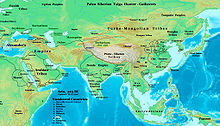Massageterne



Massageterne var et nomadisk folk bosat på de centralasiatiske stepper og øerne i floden Amu Darja.
Massageterne boede ved det nordøstlige af det kaspiske hav i det moderne Turkmenistan, vestlige Uzbekistan - og det sydlige af Kazakhstan.
Massageterne tilhørte Saka-folket,[1][2] og var en del af den Skytiske kultur,[3]
Referencer[redigér | rediger kildetekst]
- ^ Schmitt, Rüdiger (2021). "Massagetae".
- ^ Schmitt 2018.
- ^ Unterländer, Martina (3. marts 2017). "Ancestry and demography and descendants of Iron Age nomads of the Eurasian Steppe". Nature Communications. 8: 14615. doi:10.1038/ncomms14615. PMC 5337992. PMID 28256537.
During the first millennium BCE, nomadic people spread over the Eurasian Steppe from the Altai Mountains over the northern Black Sea area as far as the Carpathian Basin... Greek and Persian historians of the 1st millennium BCE chronicle the existence of the Massagetae and Sauromatians, and later, the Sarmatians and Sacae: cultures possessing artefacts similar to those found in classical Scythian monuments, such as weapons, horse harnesses and a distinctive ‘Animal Style' artistic tradition. Accordingly, these groups are often assigned to the Scythian culture...
- Schmitt, Rüdiger (2018). "MASSAGETAE". Encyclopædia Iranica Online.
